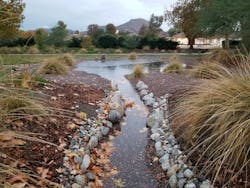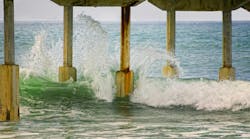Shanna Delgado is an environmental scientist for CASC Engineering and Consulting. Delgado can be reached at [email protected].
NPDES, LID, and BMP are all acronyms that any developer in California should be familiar with these days, and over the years California has adopted a more stringent policy on treating storm water runoff prior to discharge from any new development or significant redevelopment project. In the past, solutions to these storm water treatment regulations consisted of costly and unappealing traditional best management practices (BMPs) like detention basins and infiltration basins.
Traditional storm water methods convey the runoff directly into storm drains, pipes and channels, which eventually lead to the receiving waters, carrying all kinds of pollutants and trash with it. Current regulations require developers to capture and retain the pollutants on-site through a variety of LID BMPs and LID Principles. Current LID BMPs focus on infiltration, evaporation, filtration, storage or detention of site runoff. By incorporating these LID BMPs sites can reduce pollution, reduce storm water discharges, increase infiltration, reduce potable water for irrigation, recharge the groundwater table, and provide many other environmental benefits.
Lead by Example
Since 1993, CASC Engineering and Consulting, Inc. (CASC) has united theory with practice in guiding government agencies, private developers, and contractors through the regulatory requirements of the National Pollutant Discharge Elimination System (NPDES) permits. In these roles, CASC routinely recommends or reviews BMPs designed or implemented by others. As an exercise of practice-what-one-preaches, Rick Sidor, owner, initiated the selection, design, construction, operation and maintenance of BMPs at CASC Headquarters. The LID BMPs implemented include two areas of pervious paving, two infiltration trenches, two infiltration basins, one area of precast porous concrete panels, one area of pervious interlocking pavers, one roof-runoff diversion system and three areas of turf conversion.
A Living Classroom
The LID BMP Retrofit Project consisted of retrofitting a 1.7-acre commercial office site with a single tenant, CASC. Constructed in the 1980s, the commercial office site existed long before the mandate of LID BMPs, and currently neither the City nor the Phase I MS4 Permit require a LID BMP retrofit for the site. As a completely voluntary effort, CASC designed and implemented the LID BMP retrofit for their corporate office facility, completing construction of the latest BMP in July of 2020. The project was initially introduced to improve deteriorated areas and parking lot drainage: additionally, this endeavor was seen as a good training opportunity for employees and clients. Eventually the project evolved to meet different goals over the years since it began.
The first advance for the project began in 2012, as CASC was moving into the building and desired to improve areas of the parking lot. Instead of replacing the deteriorated areas with typical asphalt concrete, permeable concrete pavement was installed. This BMP reduced the direct discharge area by almost 9% of the site. Overall maintenance has been minimal, however for the first time in 8 years since its installation, CASC was forced to clean the porous pavement when an upstream contractor hit a large water main and caused sediment laden flows to back into the parking lot. With advice from porous pavement experts, CASC staff used a detergent, hose and shop vac to clean it. To this day the BMP is holding up nicely and performing as designed.
Later in 2012, CASC sought to improve an area located along the northeastern boundary of the lot, which had underlying drainage issues, especially during the rainy season. The waterlogged area was determined to be a prime location for the East Infiltration Trench. The initial process included removal of soil and excavating a 12-inch trench then backfilling the trench with gravel. The excess soil was repurposed for decorative landscaping mounds in the surrounding areas. The infiltration trench reduced direct discharge by another 4%. During winter in early 2020, the same upstream contractor did not control their construction site runoff and flooded the east infiltration trench, which nearly entered the building. The muddy waters clogged the gravel reservoir and rendered the east infiltration basin useless. Repairs consisted of removal and disposal of the clogged gravel, increasing the depth of the trench, addition of a liner (to the building side of the trench only), installation of an underdrain system and finally, backfilling the trench with clean gravel.
The motivation for the next BMP came from a cost-saving perspective. The insurance company had informed CASC of the liability posed by retaining their loading dock and that General Liability Insurance rates will be raised. Additionally, there was 8,500 square-feet of turf to consider, which had required substantial watering during a severe drought. CASC’s solution consisted of an infiltration basin to replace the turf and to use the excess soil to fill in the loading dock. One of the biggest challenges CASC staff faced occurred two feet into the basin excavation. The first infiltration test showed the team had dug into a silty loam layer of soil with very low permeability. Considering soils ideal for percolation lie in Reche Canyon Creek just south of the site, CASC excavated another four feet and uncovered a layer of sandy soil with very high infiltration attributes. The trench was then filled with gravel and diversion ribbon gutters were constructed and routed towards the basin from the parking lot. This West Infiltration Basin substantially reduced the direct discharge of the site by an additional 43.7%.
In 2017, CASC identified another problem that could be resolved with yet another infiltration BMP. Mature palm trees planted in the 80s had grown root balls so large that roof runoff diverted toward the building windows causing rainwater to seep under the glass. Just like the previous trench, CASC excavated the area and backfilled the trench with gravel. This North Infiltration Trench eliminated more turf with an attractive, maintenance free alternative. About 2% of the site’s runoff infiltrates in this small trench.
Later in 2017, CASC decided to eliminate another 4,000 square-feet of turf with one more infiltration basin. The design consisted of removing the grass area and diverting flows while improving upon some of the lessons learned from the first basin. This South Infiltration Basin was more about the aesthetics and the CASC in‐house landscape architect, Ed Gerlach was all in. The basin was hollowed out and the soil was utilized to create landscape mounding, and once more, the basin was excavated to about 5 feet to find the permeable sand layer. Decorative rocks were used on the surface and landscaped mounds with drought tolerant vegetation surrounding the perimeter. This BMP captures runoff from over 30% of the site, capturing some of the flows that previously drained to the West Infiltration Basin.
Next was to consider how to divert flows from almost half an acre of impervious surface into the west basin. This time the motivation was to redirect flow from an area that originally drained toward a completely undersized “parkway drain”, which would back up and cause ponding in the parking lot. The chosen solution was the addition of an aesthetically pleasing roof run-off diversion system, integrating decorative boulders and a concrete curb, which captured and conveyed flows away from the street and into CASC’s West Infiltration Basin. This BMP diverted flows from about 7,800 square-feet of impervious surface Into the West Infiltration basin.
In 2019, CASC had another opportunity to enhance the site aesthetically by installing some pervious paving stones over the loading dock area. The site was thought to be a good location to showcase the Angelus product. CASC provided the base materials, equipment and labor to complete the Ramp Permeable Pavers BMP.
Also in 2019, StormCrete saw the site as an opportunity to showcase their product, pre-cast porous concrete panels and provided materials for CASC to add permeable paver parking stalls near the west basin. CASC benefited by removing a little more turf to gain a few needed parking stalls without creating additional runoff.
Benefits of Retrofit
Prior to the retrofit, 100% (73,507 square-feet) of the site drained directly to the street or adjacent creek. After the retrofit, only 14,983 square-feet drained offsite, a reduction of 79.6%. The BMPs successfully reduced the site’s storm water discharges, increased infiltration, reduced potable water used for irrigation and provided an opportunity for others to see how LID BMPs can be effectively integrated into a new or existing commercial site. By converting the pre-project turf areas into LID BMPs and drought tolerant landscaping, CASC has minimized irrigation costs and decreased maintenance from mowing the lawns on a weekly basis to occasionally pulling weeds from the infiltration basins.
Not only did the project provide functional LID BMPs that reduced irrigation costs, but the aesthetic benefits of the project were extensive, effectively converting the site from a general commercial office building to a commercial office campus. This project demonstrates a feasible model for how a commercial property can be effectively retrofitted with LID BMPs that are functional, aesthetically pleasing, and cost effective. As to whether CASC will eventually capture and retain 100% of the site’s runoff, only time will tell.






